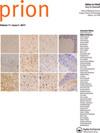Cellular prion protein distribution in the vomeronasal organ, parotid, and scent glands of white-tailed deer and mule deer
IF 1.6
3区 生物学
Q4 BIOCHEMISTRY & MOLECULAR BIOLOGY
引用次数: 4
Abstract
ABSTRACT Chronic wasting disease (CWD) is a contagious and fatal transmissible spongiform encephalopathy affecting species of the cervidae family. CWD has an expanding geographic range and complex, poorly understood transmission mechanics. CWD is disproportionately prevalent in wild male mule deer and male white-tailed deer. Sex and species influences on CWD prevalence have been hypothesized to be related to animal behaviours that involve deer facial and body exocrine glands. Understanding CWD transmission potential requires a foundational knowledge of the cellular prion protein (PrPC) in glands associated with cervid behaviours. In this study, we characterized the presence and distribution of PrPC in six integumentary and two non-integumentary tissues of hunter-harvested mule deer (Odocoileus hemionus) and white-tailed deer (O. virginianus). We report that white-tailed deer expressed significantly more PrPC than their mule deer in the parotid, metatarsal, and interdigital glands. Females expressed more PrPC than males in the forehead and preorbital glands. The distribution of PrPC within the integumentary exocrine glands of the face and legs were localized to glandular cells, hair follicles, epidermis, and immune cell infiltrates. All tissues examined expressed sufficient quantities of PrPC to serve as possible sites of prion initial infection, propagation, and shedding.细胞朊病毒蛋白在白尾鹿和骡鹿犁鼻器官、腮腺和气味腺中的分布
慢性消耗性疾病(CWD)是一种传染性和致命性的海绵状脑病,影响子宫颈科的物种。CWD具有不断扩大的地理范围和复杂的、鲜为人知的传输机制。CWD在野生雄性骡鹿和雄性白尾鹿中尤为普遍。性别和物种对CWD患病率的影响被假设与涉及鹿面部和身体外分泌腺的动物行为有关。了解CWD传播潜力需要了解与宫颈行为相关的腺体中的细胞朊蛋白(PrPC)的基础知识。在本研究中,我们鉴定了PrPC在采食的骡鹿(Odocoileus hemionus)和白尾鹿(O. virginianus)的6个被皮组织和2个非被皮组织中的存在和分布。我们报道了白尾鹿在腮腺、跖骨和指间腺中的PrPC表达明显高于骡鹿。雌性比雄性在前额和眶前腺表达更多的PrPC。PrPC在面部和腿部表皮外分泌腺的分布局限于腺细胞、毛囊、表皮和免疫细胞浸润。所有被检测的组织都表达了足够数量的PrPC,作为朊病毒初始感染、繁殖和脱落的可能位点。
本文章由计算机程序翻译,如有差异,请以英文原文为准。
求助全文
约1分钟内获得全文
求助全文
来源期刊

Prion
生物-生化与分子生物学
CiteScore
5.20
自引率
4.30%
发文量
13
审稿时长
6-12 weeks
期刊介绍:
Prion is the first international peer-reviewed open access journal to focus exclusively on protein folding and misfolding, protein assembly disorders, protein-based and structural inheritance. The goal is to foster communication and rapid exchange of information through timely publication of important results using traditional as well as electronic formats. The overriding criteria for publication in Prion are originality, scientific merit and general interest.
 求助内容:
求助内容: 应助结果提醒方式:
应助结果提醒方式:


